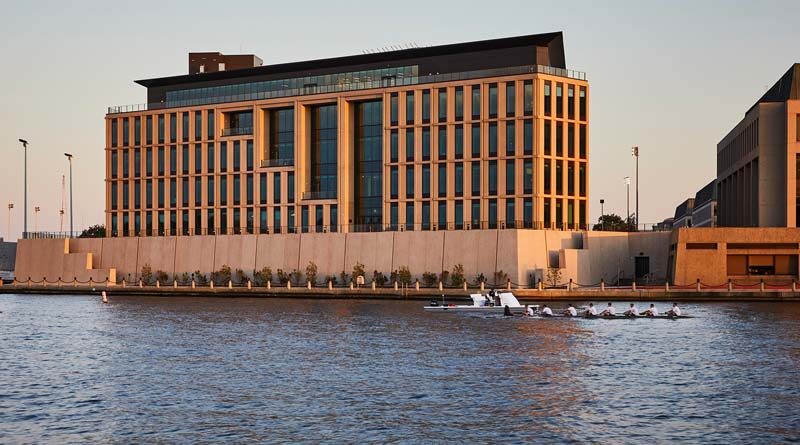Naval Academy’s New Cyber Studies Venue Targets LEED Silver
By SCN Staff
ANNAPOLIS, Md.—Skidmore, Owings & Merrill (SOM), Turner Construction Company, and the United States Naval Academy (USNA) recently celebrated the completion and opening of the USNA Cyber Studies Building – Hopper Hall. The facility, a design-build project led by Turner and designed by SOM, is the first building at a U.S. military academy dedicated to the study of cyber security. The project is designed to achieve LEED Silver certification from the USGBC.
Named for Rear Admiral Grace Hopper, a pioneer in computer science and one of the original developers of the world’s first commercial electronic computer, the building is the first academic structure named after a woman at a major U.S. service academy. It signifies a major step forward in the evolution of the U.S. military – almost five decades after the last academic USNA structure was erected, Hopper Hall advances a rapidly modernizing curriculum, one that will foster the next generation of military leadership.
The USNA campus is home to a diverse range of architectural styles, from Beaux-Arts to modernism. The site of Hopper Hall, at the edge of Isherwood Terrace along the Severn River, is located among the modernist Nimitz Library and Rickover Hall. The new building’s architecture is inspired by its neighbors, both in its massing and its materiality. Hopper Hall features a horizontal massing and a regular grid of punched windows that resemble the designs of the adjacent buildings, and its precast concrete facade echoes the color and texture of the stone and concrete surrounding Isherwood Terrace.
On the ground floor, Hopper Hall extends Isherwood Terrace into a two-story, 6,000-square-foot communal space called the “Bridge.” This informal lobby can transition into an event hall for exhibitions, presentations, and other ceremonies. The space begins at the building’s entrance and ends near an outdoor staircase leading to the waterfront, and it is aligned with the center of the terrace. This alignment, coupled with a full-height curtain wall on both ends, preserves historic views of the water.
Hopper Hall houses four departments within the cyber security discipline: Cyber Science, Computer Science, Electrical and Computer Engineering, and Weapons Robotics Controls. Approximately 70 percent of the six-story building is utilized for instruction and research within these departments, with a combined 68 classrooms, seminar spaces, laboratories, and research facilities. These rooms are supplemented by faculty offices, as well as a cafe and a multitude of additional spaces that bolster education in both cyber security and other USNA curricula.
The building includes a power studio lab, a green energy lab, an optics lab, an anechoic chamber, and an auditorium beside the faculty offices. It also augments the Robotics and Control Engineering major with an aerial robotics testing facility and, on the top level, an observatory serves as a valuable new resource for coursework in physics and other majors. On the ground level, two aquatic testing facilities – the Surface and Underwater Robotics Facility (SURF) and the Shared Waterfront Activities Lab (WAL) – are equipped with highly advanced technology, including sand filtration, sanitizing systems, video-capturing equipment, a three-dimensional motion-tracking system, and a monorail capable of lifting submersible vehicles weighing up to two tons.
The LEED® Silver certification will be targeted primarily by optimizing air quality, water use, energy performance, its window-to-wall ratio, and in its resiliency measures. The building’s resiliency features navigate the technical challenges of the site: Hopper Hall lies on reclaimed land within the 100-year floodplain. As a perimeter building, it had to be blast-resistant and floodproof, and incorporate a programmatic resiliency. This resiliency is achieved, in part, through the building’s stacking, in which the aquatic-based labs are located in the base of the building – where the facade is most solid – while the data labs, faculty offices, and instructional and event spaces are housed on the higher floors.
Skidmore, Owings & Merrill (SOM) is a collective of architects, designers, engineers and planners, responsible for some of the world’s most technically and environmentally advanced buildings, and significant public spaces. Turner is a North America-based, international construction services company founded in 1902.

